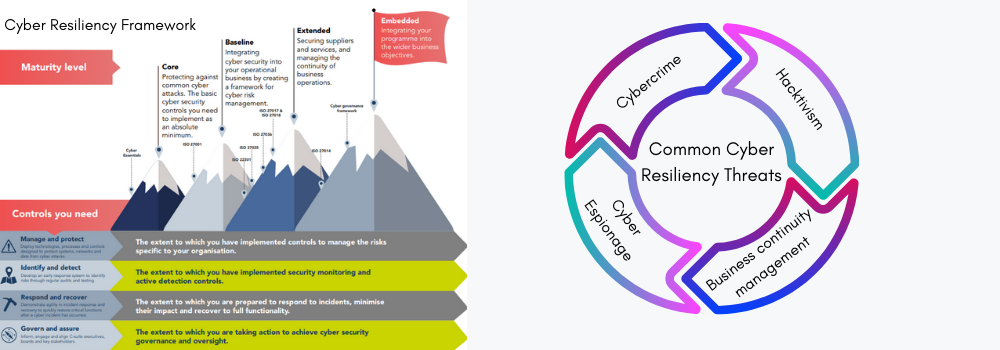
- Home
- Services
- Solutions
- Compliance
- RBI Cyber Security Framework For Banks
- SEBI Cyber Security & Cyber Resilience Framework
- UIDAI – AUA KUA Compliance Security
- RBI Guidelines for Payment Aggregators & Payment Gateways
- RBI Cyber Security Framework For Urban Cooperative Banks
- RBI Guidelines for cyber security in the NBFC Sector
- SAR Audit
- ISO27001
- PCI DSS
- GDPR
- Hipaa Audit
- SOC2 Assessment
- Resources
- Company
- Contact
How Cyber Resilience Reshapes Cybersecurity?
Cybercrimes are growing swiftly in the world of digitalization in both senses; complexity and rate of recurrence. In the idea of being resilient in an impulsive environment, an organization’s cyber security has to be updated with the latest technologies to protect IT Assets and Infrastructure setup. The old school security methodologies cannot be an answer for new-age sophisticated cybercrimes. The organization having a robust cybersecurity resilience strategy in place is a must that enables the continuity of business processes in all situations (before, during, and after a cybersecurity incident).
As per the research conducted by Cybersecurity Ventures in 2021, there will be one company that falls victim to a ransomware attack every 11 seconds.
What is Cyber Resilience?
Cyber Resilience can be defined as the competency of an organization to anticipate, withstand, recover from and adapt to adverse conditions, stresses, attacks, or compromises on systems that are used or enabled by cyber resources.
As we are evident of increasing cyber threats, cyber resilience has become equally important fundamental in shaping the accomplishment of an organization. Cyber resilience is a wall for defending and continuing businesses against cybercrimes, addressing risks, and reducing aftershocks of attacks. A cyber-resilient organization is ready with regards to taking up challenges put front by cybersecurity incidents and can effectively respond to and quickly recover when such events do occur.
What is needed for a Cyber Resilience Framework?
Witnessing a sudden spike in cybercrimes during the COVID-19 situation, the majority of organizations would admit that cyberattacks are no longer a matter of Why, When & How. In such an environment, organizations should make sure of having adequate controls in place, not just to avoid cybercrimes but to protect critical assets also, and they should think to surpass any obstacles as and when the disasters strike. In order to improvise the overall security posture and have a resilient Cybersecurity program for an organization, one must make sure to implement a complete cyber resilience framework. A cyber resilience framework should consist of below mentioned six key factors.
- Identify
The first factor of a cyber resilience program should be identifying critical business functions and assets. Performing risk assessment will be the key to identifying critical business functions and assess cybersecurity risks that could potentially disrupt them. It is really important to understand and manage the risks associated with an organization’s network, IT infrastructure, and information systems.
- Protect
As we have identified critical assets and business functions, the next factor asks us to deploy the required policies, tools, and technologies and implement necessary security measures just to make sure that all critical assets and business functions are secured. As a part of this factor to be met we need to train our employees, implement information security policies, manage access control, and maintain IT infrastructure.
- Detect
The third factor requires us to keep scanning IT systems regularly so that we are aware of recently introduced vulnerabilities and are prior informed of possible suspicious activities for the open gaps. This helps us to prepare and analyze for potential impact on our business. This step includes continuous monitoring to catch anomalies and cybersecurity risks in the early stage so that we can take necessary steps to protect our sensitive data and IT components from cyberattacks, system downtimes, and unauthorized access.
- Respond
Once we detected all the open gaps, this factor automatically gets its leverage which seeks to take appropriate measures and controls implementation. This mitigates the identified vulnerabilities in compliant manner. It even asks us to be prepared with an incident plan so that we are ready with all our defensive strategies if someone attacks our IT systems. This is an important function of a cyber resilience framework that showcases the preparedness of organization when a cybersecurity incident occurs.
- Recovery
The recovery factor is one defense in itself that helps us to formulate the action plan to return back to normalcy post-incident disruption. These actions defined in this stage mainly focus over restoration of systems, applications or data impacted by a security incident or system breakdown. Having proper DR (Hot, Warm or Cold) site as per the criticality of function, preparedness in pandemic breakdown or any other Business continuity situation having smooth transitioning of work is a must. This factor helps us ensure that there is minimal or no impact on critical business functions or capabilities in any situation.
- Adapt
A cyber resilience program is not an “implement and overlook” kind of a program. An organization needs to work on maintaining, review, continuous improvements and modifications to tackle new age complex cyberattacks & breakdowns. Modern-day businesses require advanced solutions.

How Can Cyber Resilience Be Improved?
There are basic action items that brings Cyber resiliency to an organization. Here are four actionable insights that you can implement to strengthen your organization’s cyber resilience program:
Automation: Cyber espionage is trying to be more tough and complex to understand. In that case depending on a manual process to combat cybersecurity risks is not enough. Future Centric organization are accepting artificial intelligence (AI) and machine learning (ML) to automate critical functions that easily helps them to identify bad actors and anomalies relatively faster, analyse risks more comprehensively and action to get rid of cyber incidents in a timely fashion. Automation not only helps in decreasing the count of errors but also helps to improve efficiency and accuracy which leads to incorrect decision makings.
Implement Stringent Security Protocols: Whenever there is question of data security, we cannot trust anyone, not even internal stakeholders. In fact, the amount of insider threats has increased by 47% in recent years. An organization must reinforce rigorous security policies, such as multi-factor authentication, identity and access management, and cryptograph highly restricted digital assets to reduce the risks of data loss and unauthorized access.
Make Cyber Resilience a Part of Your Corporate Culture: The security of organization is not the responsibility of your IT team only. Employees of the entire organization is responsible. Conducting Social engineering test, online knowledge testing is required to understand the weakness among the people.
Back-Up Your Data: Having a copy of data as and when disaster strikes, is the last resort in case of incident succeeds in breakdown the system. Backing up your data resolves your continuity of process-related issues as we can quickly restore and recover from any unforeseen disruptive events.
Need of Cyber Resilient Programme
Thinking of IT is not sufficient to have a resilient Cyber Security framework. The planning should focus on achieving cyber resilience and its concrete, measurable results.
Create awareness among stakeholders. Think about future, instead of going for short term patches for problems, develop long term strategies and work to implement those in IT infrastructure so that we are future ready.
Resilience and Recovery are said to be two comprehensive pillars of corporate resilience. When working on detailing, the attention should also be towards timelines to deploy, execute, and achieve results.
As a business enterprise, the management and security team need to be agreed upon what success will look like.
If implemented correctly, security will be in the execution stage, not the outage. Security experts need to inform their teams about their actions and provide guardrails that will bring agility and creativity to the smooth functioning of the business.
WeSecureApp can monitor your organization providing a simple, easy-to-understand cybersecurity rating and automatically detect leaked credentials and data exposures. Extended support from our team of experts to help you evaluate and fix the issues in a timely manner.
If you’d like to see your organization’s security posture – Talk to Our Delivery Head








